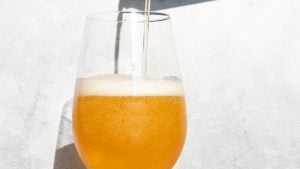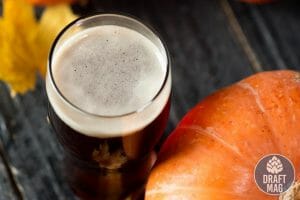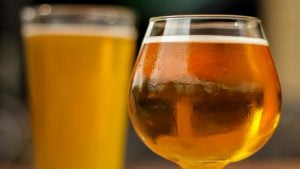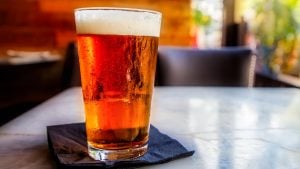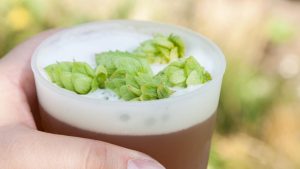Mango IPA Recipe: Brewing Delicious Beer with Mangoes
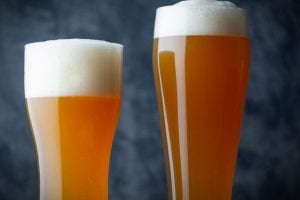 Looking for a mango IPA recipe for the summer? Discover what the addition of fruit to a brewing process can create. If you love beers with a distinct hoppy flavor, you should try this recipe, and tell us what you think! Do not worry, even if you have never brewed beer before, you will find this recipe manageable.
Looking for a mango IPA recipe for the summer? Discover what the addition of fruit to a brewing process can create. If you love beers with a distinct hoppy flavor, you should try this recipe, and tell us what you think! Do not worry, even if you have never brewed beer before, you will find this recipe manageable.
– Overview
- Mango IPA beer definition
- Alcohol content in Mango IPA
- How it tastes like
- Brewing a Mango IPA
What Is Mango IPA Beer?
Mango IPA is a fruit beer with tropical notes that complement the citrus flavor in hops perfectly. People have been using fruit in the beer brewing process for centuries, but recently fruity beers are gaining popularity again.
Indian pale ales (IPAs) have quenched people’s thirst from the 19th century from Britain to India. As history reveals, the British colonized India and the soldiers stationed in India needed beer to relax while off duty. To ensure the beer got to the soldiers without going bad, the brewers added additional hops to act as a preservative.
To this day, the creation of IPAs features a large quantity of hops, which gives it a distinct aroma and slightly bitter notes. Depending on the hops used, the beer produced will manifest different notes of citrus, grapefruit, or pine. You can find a variety of different IPAs such as American IPAs, black IPAs, New England IPAs, and mango IPAs among many more.
Alcohol Content in a Mango Pale Ale
Typically, ales do not have a high alcohol percentage; therefore, a single mango session IPA will not get you drunk because the percentage of alcohol is under 5 percent. A mango IPA beer features an ABV between 3.5 percent and 7 percent, depending on the amount of sugar used during the fermentation process. The more the sugar used, the more food yeast has to produce alcohol.
If you want your mango ale not to be too astringent, reduce the quantity of hops and time the hops spend boiling. The shorter they boil, the lower the intensity of the flavor imparted in the brew.
Mango IPA’s Taste and Smell
Citrus notes with earthy tones are the most recognizable flavors arising from mango pale ales. Depending on the variety of hops used, the flavors produced will vary. For example, Crystal hops are spicy, while Chinook hops have a significant pine flavor. If well brewed, most mango IPAs have tropical notes in the beginning followed by a slightly bitter aftertaste.
In terms of aroma, you will get notes of fresh mangoes, followed by fruity and citrusy notes from the hops. As reiterated above, the flavor and the aroma of the beer are highly influenced by the type of hops used, and the quantity of fruit. If you use little mango, the flavor and the aroma will not be as strong.
Mango Pale Ale: How Many Calories Does It Have?
For mango IPAs, the calorie count is between 130 – 250 calories per 12 oz. The brewing process affects the calorie content in any beer. Most brewers lower the calorie content in their beers by either reducing the alcohol content or the carbs.
Reducing the alcohol content means reducing the quantity of sugar and cutting back on carbs requires the introduction of enzymes. If you do not want to reduce the alcohol content in your recipe, enzymes such as Amyloglucosidase will assist break down the carbohydrates into simple sugars.
The good thing about mango IPAs is that they do not have too many calories. About 28 minutes of cycling, 18 minutes of running and an hour of cleaning should help you lose 184 calories. To know your homemade beer’s calorie count, go online and use a beer calorie calculator, which is free.
Brewing Mango IPA: What Do You Need?
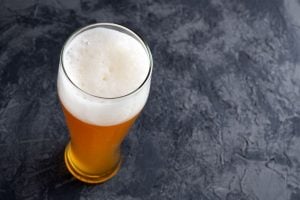 Making beer at home is easy as long as you have all the ingredients. This all grain mango beer recipe needs:
Making beer at home is easy as long as you have all the ingredients. This all grain mango beer recipe needs:
- Mangoes –1kg
- Red Malt –1 ½ tablespoons
- Pale malt –1kg
- American hops –18g or more depending on preference
- Oat flakes –140g
- Water – 6 liters
- Brewer’s yeast – 5g
- Thermometer
- Wooden spoon for mixing
- A beer fermenter
How To Brew Mango IPA
It is good to note that people tweak recipes to suit their own preferences. Therefore, feel free to adjust it accordingly to the amount you want to make. Once you have gathered all the ingredients, proceed to:
- Start the mashing process by heating 1 gallon of water on the stove, adding the oats, red and pale malt to the water, cover with a lid and let it attain 135 degrees Fahrenheit. Turn the heat off and let the mixture sit for 15 minutes. Turn the heat back on and let the mixture heat to 153 degrees Fahrenheit. Once the temperature is attained, turn off the heat and let the mixture sit for an hour.
- An hour later, reignite the cooker and let the mixture boil to 172 degrees Fahrenheit and let it boil for 15 minutes. As the mixture boils, place the remaining half gallon of water in a separate pot and boil to 172 degrees Fahrenheit. Let the mixture cool for 15 minutes.
- Separate the wort from the particles using a sieve. Wort is a liquid that contains all the sugars that the yeast will consume to create alcohol. Place the debris back in the pot and add the half gallon of water that was heating at 78 degrees. This procedure is called sparging and it is intended to harvest the remaining sugar from the grains after removing the initial wort.
- Let the grains and water sit for 10 minutes then drain again and add to the initial wort. Put the wort back on the stove and raise the heat to get the mixture boiling. Add the preferred quantity of hops together with the sliced mango and let it boil for an hour. It is better to work with large mango sections than smaller parts, because of easier retrieval later.
- Cool the wort in a basin of cold water to room temperature before adding the yeast. Remove the mango pieces from the wort and rehydrate the yeast. At this point, you can check the gravity of beer using a hydrometer to determine the quantity of alcohol expected. The ideal reading should be around 1,050.
- Pour the wort into the fermenter and add the dehydrated yeast ensuring to secure the airlock. The airlock should have a stopper to allow the carbon dioxide out and prevent oxygen from escaping. Let the fermenter sit in a dark place for 14 days. After 14 days, you will notice significant Kräusen at the top, bubbles, and grain sediment at the bottom.
- If you are storing in bottles, place about 0.35 ounces of priming sugar or corn sugar per liter. This is to promote carbonation instead of consuming a flat beer.
Popular Mango IPA Brands
Apart from brewing mango IPA at home, you can find various mango IPA brands in the market. These brands vary in price range and flavor intensity so have fun trying them with friends or family.
- Golden Road Brewing Mango Cart: Brewed in the USA, this 4 percent ABV mango beer utilizes bravo hops and 2-row wheat malt. The mango flavour in this IPA beer is louder than the wheat making it a tropical treat for summer.
- Mango Habanero IPA by Motorworks Brewing: The pale Indian ale has an ABV of 6 percent and features Citra, Chinook, and Amarillo hops.
- Wasatch Brewery mango IPA: This is an American-style IPA featuring Galaxy and Mosaic hops that complement the mango flavor. The 5 percent ABV beer is available for purchase in 12 oz. cans.
- Suzy Greenberg Mango IPA: Hailing from the award-winning Back East Brewing Company, this 5.6 percent ABV mango beer offers a faint mango flavor with citrus notes. The hops flavor in this drink is mild but the smell of mango is pronounced.
- Brewski Mangofeber DIPA: This is a double/ imperial IPA with an alcohol content of 8 percent, which is higher than session IPA beers. The Swedish IPA features Amarillo and mosaic hops that blend in with the slight mango flavor.
FAQ
What other fruits can be added to IPA beer apart from Mango?
Some popular fruit additions to IPA beer include pineapple, passionfruit, and grapefruit. Experimentation with other fruits is common in the craft beer industry.
How popular is fruit IPA?
Fruit IPA has gained popularity in recent years, particularly among craft beer enthusiasts. However, its popularity may vary by region and demographic.
Is IPA more bitter than Lager?
Generally, IPA beer has a higher hop content than lager, resulting in a more bitter taste. However, bitterness levels can vary depending on the specific beer.
Conclusion
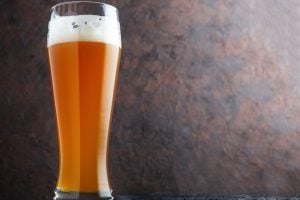 The popularity of fruit IPAs is gaining momentum as the craft beer industry continues to grow. Mango pale ales are perfect for summer so they will be in circulation for years to come. You can make them a staple in your parties and make memories. Before you go, remember to:
The popularity of fruit IPAs is gaining momentum as the craft beer industry continues to grow. Mango pale ales are perfect for summer so they will be in circulation for years to come. You can make them a staple in your parties and make memories. Before you go, remember to:
- Watch the temperature when brewing IPAs to ensure the release of all the sugars from the grains.
- During the fermentation process, store the beer in a dark place as light skunks the beer making it taste like Sulphur.
- You do not have to use one variety of hops, mix them up to get varied flavor profiles.
- Mango IPA alcohol content will vary depending on the brewing process. You can go as high as 9 percent ABV if you wish.
You might not get it right the first time but do not give up! Keep trying until you get it right. Get the brewing process started and let us know in the comment section how it went! All the best!

